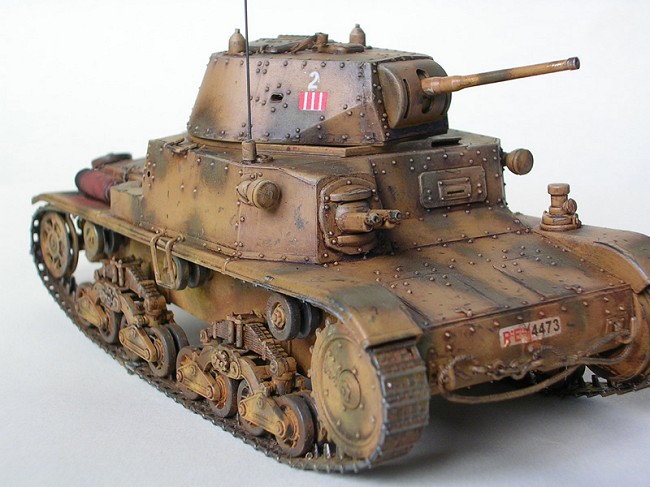
Zvezda 1/35 Ansaldo M 13/40
| KIT #: | 3516 |
| PRICE: | $17.95 MSRP |
| DECALS: | two options |
| REVIEWER: | Laurent Moitrot |
| NOTES: | ex-Italeri mold |

| HISTORY |
It is, nowadays, a common attitude to laugh at the Italian tanks from WW2. As I read somewhere: “give them four wheels and they will build the finest cars but give them tracks and there’s nothing good to expect from them” … well this is not exactly what happened.
As obsolete as it looks like, the M 13/40 was considered by no one else than Field Marshal Erwin Rommel as “as good as our own Pz. Kpfz III”. Of course he said that in early 1941 and by the time the M 13/40 had to fight against the Sherman tanks and the heavy British Matilda it was obsolete, but the Italian headquarters and their short sighted doctrine about the proper use of tanks was more to blame for what ultimately happened than the actual tanks or the crews who drove them to war.
 The
Corpo Caristi
(Armored Corps) was created in 1926.and by the end of 1927 five battalions
were equipped with Fiat 3000 tanks (basically the old French FT 17 from
world war one, with a single machine gun). In spite of some 80 Fiat 3000
/30 which carried a 37 mm gun, the obvious choice for the up rising Italian
Armored corps wasa lighter Carden-Loyd (later called L3,) tracked vehicle
with one single machine gun. You have to remember that, at that time Italy
was not an industrial country and its resources were scarce.
The
Corpo Caristi
(Armored Corps) was created in 1926.and by the end of 1927 five battalions
were equipped with Fiat 3000 tanks (basically the old French FT 17 from
world war one, with a single machine gun). In spite of some 80 Fiat 3000
/30 which carried a 37 mm gun, the obvious choice for the up rising Italian
Armored corps wasa lighter Carden-Loyd (later called L3,) tracked vehicle
with one single machine gun. You have to remember that, at that time Italy
was not an industrial country and its resources were scarce.
By 1933 more powerful versions of this L3 were produced in significant quantities by Fiat-Ansaldo. They were delivered to the cavalry regiments and to the infantry support troops and organized in 4 “infantry tank regiments”. This organization proved rather successful in Ethiopia but failed to achieve success in Spain against more organized troops with Russian made anti-tank guns.
In 1936 the Italians began to think of a new organization, built around the new m 11/39 “breakthrough” tank. This meant the creation of the first armored brigade, which soon evolved into two brigate corazzate (mechanized brigades) each one being constituted by one tank regiment (with three or four battalions), one motorized infantry regiment, AA guns , anti-tank guns and an engineers battalion.
This was basically the French D.C.R. brigade of the 30’s.
Of course what happened to the French happened to the Italians too. The Italians would have been more inspired to copy the Germans than the conservative French doctrine.
In 1939 the second brigata corazzata became the nucleus of the 132nd armored division “ARIETE” and the first brigata became the 131st armored division “LITTORIO”.
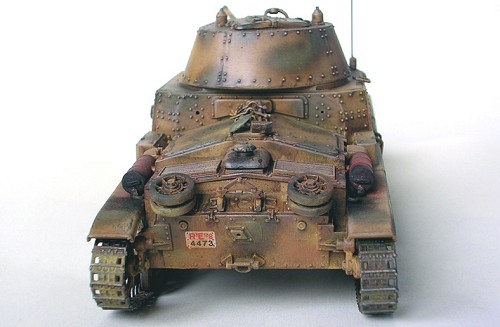 It soon became obvious that
the M 11/39 was not powerful enough to fight against the British tanks so a
new model was put on the production line, called the M 13/40.
It soon became obvious that
the M 11/39 was not powerful enough to fight against the British tanks so a
new model was put on the production line, called the M 13/40.
The M 11/39 and the M 13/40 shared the same engine and bolted hull. The M 13/40 carried a more powerful 47 mm gun in a rotating turret when the older M 11/39 carried a pillbox-mounted gun of the same caliber but with a slower velocity hence a lesser armor piercing capacity. In fact one could find the same difference between the American M3 “Lee- Grant” and the M4 “Sherman”.
The M 13/40 also carried a twin 8 mm machine gun on the front of the hull and an anti aircraft machine gun could be installed on the turret top.
The crew protection was good according to the standards of 1940.
When these tanks first met general Wavell ’s tanks in northern Africa, things turned into a huge mess. Being used in small groups, the M 13/40 was quickly outmaneuvered by the British tanks at Beda Fomm, Lybia. 100 M 13/40 were destroyed and 112 were captured in running order and later used by the British 6th Royal Tank Regiment.
During 1941 and 1942 the M 13/40 tanks fought with the Ariete division and later on with the Littorio division, sharing Rommel’s mix of success and defeat.
After 150 units were produced the long fenders were shortened and the tanks carried some radio equipment. On late production models the long fenders were back.
A total of 800 M 13/40 were produced when the new M 14/41 was introduced, soon to be followed by the short-lived M 15/42. It was the end of this family of tanks when in 1943 the decision was made to concentrate the production resources on the self propelled gun, semovente built on the M 13/40 chassis. But, as they say this is another story.
| THE KIT |
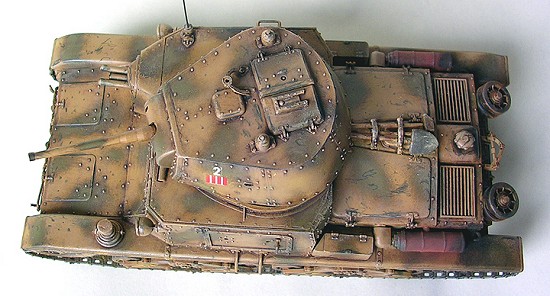 This kit is made in Russia
by Zvezda. In fact it is the old Italeri kit in a new box. Just in case you
are afraid to buy it because of the country it comes from, don’t worry, as
what you get is the standard Italeri quality. It also means that what you
get has the Italeri flaws of the old days.
This kit is made in Russia
by Zvezda. In fact it is the old Italeri kit in a new box. Just in case you
are afraid to buy it because of the country it comes from, don’t worry, as
what you get is the standard Italeri quality. It also means that what you
get has the Italeri flaws of the old days.
The kit comes in a nice grey finely molded styrene. There is no major flaw, at least nothing that a quick sanding couldn’t fix. The instructions are typically of the old Italeri style, which means no part number is molded on the sprue but you have to constantly refer to the back of the instructions sheet to check where the part you’re looking for exactly is. The instructions are sometimes vague and I must admit I had to carefully look at pictures of the real vehicle just to check. The decal sheet is simplistic and so are the two painting schemes you find on the sheet. You will have to fight to find where you’re supposed to put the decals.
| CONSTRUCTION |
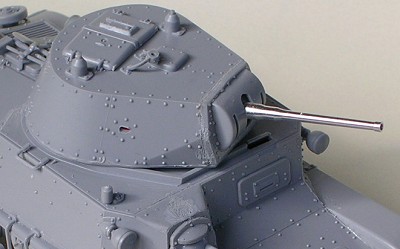 If you forget about the
lousy instructions this kit is a real pleasure to build. I decided that the
only modifications would be to use a Jordi Rubio cast aluminum gun barrel.
Not that the one which comes with the kit is not good enough, you sure can
use it, but after hearing so many people talking about this brand I decided
it was about time to try it. The only part of the kit I found hard to build
was the turret. The upper part of the turret doesn’t match exactly the
lower part nor the gun mantlet. I had to borrow a trick from our fellows
plane builders and cut a piece of sprue to use as a straightening rod while
the glue was drying, yet I still had to use some putty to help adjusting
these parts as you can see on the pic. The twin machine guns looked weird
when first I saw them. In fact they are very close to the real thing, no
matter how silly they look.
If you forget about the
lousy instructions this kit is a real pleasure to build. I decided that the
only modifications would be to use a Jordi Rubio cast aluminum gun barrel.
Not that the one which comes with the kit is not good enough, you sure can
use it, but after hearing so many people talking about this brand I decided
it was about time to try it. The only part of the kit I found hard to build
was the turret. The upper part of the turret doesn’t match exactly the
lower part nor the gun mantlet. I had to borrow a trick from our fellows
plane builders and cut a piece of sprue to use as a straightening rod while
the glue was drying, yet I still had to use some putty to help adjusting
these parts as you can see on the pic. The twin machine guns looked weird
when first I saw them. In fact they are very close to the real thing, no
matter how silly they look.
You’ll just have to drill holes to make them look accurate enough. Same problem with the mufflers. You have to drill a fine slit if you want them to look good and they sure will need some sanding and adjusting.
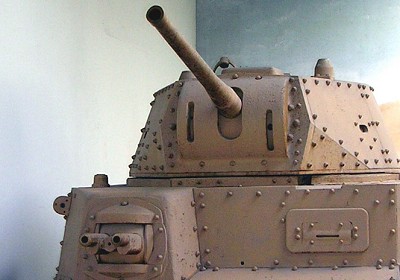 Now for the worst part of
the kit: the tracks.
Now for the worst part of
the kit: the tracks.
The tracks were probably good in the 80’s but now they look a bit … well more of the kind you’d find on some toy than on today’s models. Anyway, I decided to use them. When I build the semovente I will most certainly use some aftermarket tracks.
Be very careful with the sprockets and idler wheels as they are are very fragile. A friend of mine who built this kit a while ago broke them both while trying to put the tracks on! And when I was weathering the tank, the right sprocket broke all the same!
The tracks are so tight that there’s no way you can obtain a decent sagging. I decided the tank would be represented as “moving fast in the desert”.
One last thing I am not quite happy with is the main lights. Trying to have them look accurate required for some heavy surgery … as it comes I decided the crew just didn’t care about them when spraying paint on this tank … people used to do that sometimes.
| COLORS & MARKINGS |
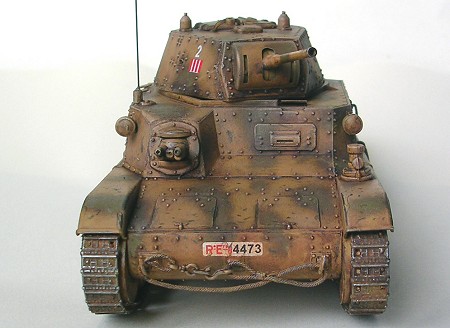 I was unable to help
myself with the decal sheet or the painting instructions so I decided to
use the box art as a reference. Many pictures of the tank show it with an
overall sand yellow, without any camouflage. The three-tone camo suggested
by the instructions seemed too dark but this yellow /green tank on the box
seemed quite appealing. One concern is that this tank is from the first
battalion as showed by the red square (the white stripes telling the number
of the company) and then should have RED digits for the tank number. The
decals give you one red digit and one white digit of each kind … I had to
search into my scrap box to find two digits of the same color. The box
shows white digits and so do some pics so I chose the white option. Maybe
the markings were not as standardized as they could’ve been.
I was unable to help
myself with the decal sheet or the painting instructions so I decided to
use the box art as a reference. Many pictures of the tank show it with an
overall sand yellow, without any camouflage. The three-tone camo suggested
by the instructions seemed too dark but this yellow /green tank on the box
seemed quite appealing. One concern is that this tank is from the first
battalion as showed by the red square (the white stripes telling the number
of the company) and then should have RED digits for the tank number. The
decals give you one red digit and one white digit of each kind … I had to
search into my scrap box to find two digits of the same color. The box
shows white digits and so do some pics so I chose the white option. Maybe
the markings were not as standardized as they could’ve been.
| CONCLUSIONS |
Despite some flaws this was a nice kit to build. If you want to end up with a prizewinner, you then will have to invest in some decent tracks… but who really needs a prizewinner when you can just have fun?
Don’t try to look for the more expensive and OOP Italeri kit and just enjoy this one as it comes.
November 2005
If you would like your product reviewed fairly and quickly, please contact me or see other details in the Note to Contributors.